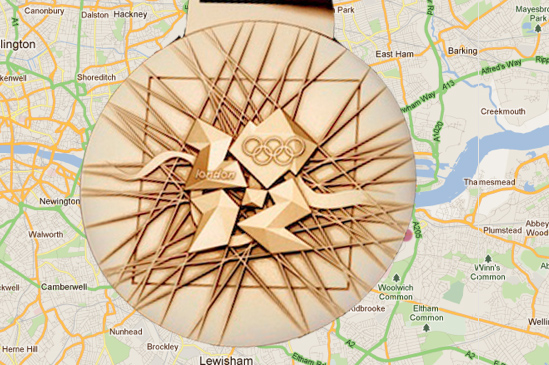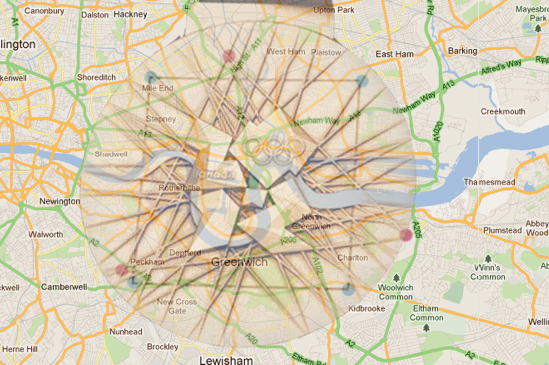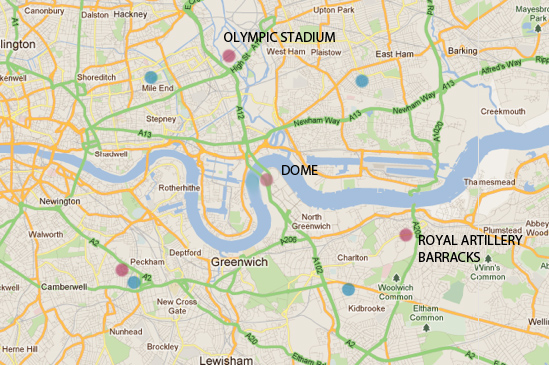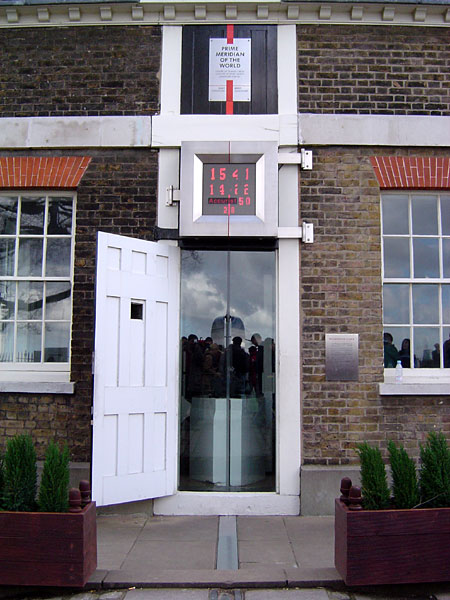Ley Lines of Zion
In this regard, an extremely interesting article appeared in the Londonist entitled, "The Secret Ley Lines Of The Olympic Gold Medal." The author of the piece noticed that the medal design matches up perfectly with the double bend in the River Thames, and with other features in the city geography around the site of London 2012.
 |
| The medal aligned with the map |
 |
| The medal design faded into the map |
 |
| Points within the design identified as landmarks on the map |
It would likely be very fruitful to extend out these "leylines" over Britain and to note what falls on them. The overall story of London 2012 would be enriched by such research. Leaving that to others, though, I'd like to focus on the area shown in this map. Where have people seen this before?
The Bend in the River
Remarkably, this particular section of Greater London has been seen by millions of British people during weekdays on primetime television every year since 1985. I am, of course, referring to the immensely popular BBC soap opera, EastEnders. Here is the original opening sequence from 1985:
Is it a coincidence that this is exactly the area that 27 years later appears as the background on the London 2012 medals, branded with the "Zion" logo? Were people for all of these years being conditioned to pay attention to this particular part of Greater London? Talk about predictive programming!
The opening sequence has changed over the years, with sequences showing the Millennium Dome (now O2) after 2000 and showing the Olympic Park after January of this year, but its music and the aerial map-like view of the land surrounding the distinctive bend in the Thames has remained constant. A 2008 poll revealed that the show's theme song is more recognizable to British people than "God Save the Queen". If the song is this widely known then surely the image of this particular area of East London is also boldly imprinted in the minds of UK citizens.
By now it is as familiar, and therefore as seemingly innocent, as water is to fish. Any suggestion that it could be otherwise is likely to be met with howls of ridicule. If I was entirely literal-minded I might be concerned about this.
The show itself, however, has a direct connection with the 2012 London Olympics. It is well known that the postal district of the neighbourhood depicted in EastEnders has the code E20. There is even a spin-off of the show entitled EastEnders: E20. This postal district was entirely fictitious, but it has become the actual postal district of the 2012 Olympic Park. E20 has, in this way, also been fixed in the public consciousness since 1985. E20 can be read as 520 and this number will also gain relevance as this analysis unfolds.
The Dome and the Obelisk
If the EastEnders opening sequence is somehow foreshadowing the 2012 Olympics it also reveals the future location of the Millennium Dome on the Greenwich Peninsula, which was opened more than twelve years before this year's Games. Does the Dome also enter into the bigger narrative leading up to London 2012?
The feminine dome is occultly conjoined with the phallic Canary Wharf (One Canada Square) on the nearby Isle of Dogs. Similar architectural couplings are found in cities throughout the world, and as monuments of the past.

Both sites were built in former industrial zones -- the Dome was constructed on land contaminated by toxic sludge -- and were part of a project to "green" East London. The Dome was refashioned as the O2 entertainment district in 2005 which will host various Olympic events.
The Measure of Time and Space
If the Millennium Dome does play a role in the buildup to London 2012, then maybe we need to stretch the timeline back quite a bit further. As mentioned, the prime meridian passes right next to the Dome and it is runs very close to the Olympic Stadium.

The meridian at Greenwich was accepted as the universal prime meridian at an international conference in Washington D.C. in 1884, but it had already been used as such for decades previously. But why Greenwich? The obvious answer is that this was the meridian that passed through the Royal Observatory, Greenwich, which was originally built in 1675. The Royal Observatory has been directed by fifteen successive Astronomer Royals since 1675, and the Royal Observatory in a sense has become the centre of both space and time.
Is the Greenwich prime meridian the real the reason why this area has attracted so much attention since 1985 -- as the setting of a hit soap opera, as the centre of the world's millennial celebrations, as the location of London's third Olympics? Even to pose this question appears ridiculous. How could it be? And in any case, it begs another question: why was the Royal Observatory constructed in this location in 1675? Is it on a leyline? Anyone?

The Vision Darkens
At the end of June, new details emerged about the fast approaching Opening Ceremony directed by Danny Boyle. The London Evening Standard's headline ran: "London Olympic 2012: green and pleasant land will give way to dark Satanic mills." If there was any doubt that London 2012 is using Blake, and particularly his words used in the hymn, Jerusalem, as a kind of script then surely it can be put to rest after this.
Aerial photos taken from over the Stadium show a dark and desolate industrial landscape, which many on the web were quick to conclude depicted the aftermath of the supposed coming nuke attack. It's interesting that the article compared the set directly to the EastEnders sequence:
Covering almost the entire centre of the stadium, the new set resembles the opening credits of EastEnders and features a representation of the Thames running through the streets of London.
Very clearly, we are to pay close attention to this area.
The Temple and the River
The Olympic park is situated in the Lower Lea Valley. The Lea River flows into the Thames directly across from the Dome.
The Lea Valley has a long history of being an industrial wasteland and it is only in recent years that efforts have been made to clean it up. Once again, the transformation of the dark Satanic mills to the green and pleasant land appears to match this area very well.
The area around the Olympic Park at one point did supports mills, some of which go back to the days of the Knights Templar. The "temple" in nearby Temple Mills refers to the Templars. The late Rik Clay intuitively grasped early on the significance of some of the names of streets and other features which surround the Olympic Park.

An article from 2008 discusses the discovery of a Victorian-era cobblestone street by archeologists more concerned with locating the original Templar mill:
His team of archaeologists from the Museum of London are carefully digging up the cobblestones and stockpiling them to be laid down in the new Olympics park.Then they begin digging deeper to search for evidence of the original Knights Templar mill, known as Temple Mills, which started the industrialisation of the Lea Valley.
The article later provides some of the history of the Templars in the Lower Lea Valley:
The Knights Templar built a water mill at Temple Mills between 1185 and 1278. A second mill was built on the opposite side of the mill stream in 1308.
A similar article about the same discovery appears on the official London 2012 website.
While the original Templar mill has yet to be found, the history of subsequent mills in the valley is much better known. The Lower Lea Valley was a major centre for the production of gunpowder and other munitions. Farther up the valley, to the north of the Olympic Park, were the Royal Gunpowder Mills which shipped their products down the Lea to the Thames. About a mile from the Park though is the famous Three Mills Island industrial centre, which include the famous House Mills. One of these three mills was also known to have been a "gunpowder mill."

An article on the House Mills website explains how these mills helped supply "the Royal Navy in its campaign against Britain’s upstart colony across the Atlantic." This area was a major hub in Britain's campaign against the American Revolution.
This all brings us back to Blake.
Prophet Against Empire
Blake was a huge supporter of the revolutionaries in America, and later wrote a major poem, America, a Prophecy, to commemorate the revolution. Blake's wider prophecy concerning America was that it was to provide the spark for the spread of democratic revolution across the world deepening and culminating in the Final Judgement and ultimate revelation. Blake's ideas on this will be explored in detail as the blog progresses.
Blake was entirely against the war efforts of the British against the Americans, and later against the French, and there is good reason to suggest that the "dark Satanic Mills" in question here are precisely the mills of the Lower Lea Valley. Blake scholar, David Erdman, points to this in his book Blake: Prophet Against Empire:
But "dark Satanic Mills" are mills that produce dark metal, iron and steel, for diabolic purposes... London was not a mill or factory city, though there was some small scale recasting and reforging of northern iron. But it was a war arsenal and the hub of the machinery of war, and Blake uses the symbol in that sense (p.396).
If it is the case that the Three Mills complex was involved in these "diabolic purposes," which history says it was, then the "dark Satanic Mills" both symbolically and physically were located almost exactly at the site of London 2012 -- the New Jerusalem.

Enter the Wake
To close, I'll just include one more obscure literary reference in an already absurd post about the site of London 2012. This comes from James Joyce's Finnegans Wake, a book also about a river and mountain on one level.
Joyce was a big fan of Blake -- and some say a disciple of sorts. Like Blake, Joyce, and especially in the Wake, is considered a prophet by some and possibly by himself. This blog will get heavily into the Wake as it evolves. For now, though, here are some suitably cryptic phrases from page 602. Keep in mind that a theory for the origin of the ancient Olympic Games is that they developed out of funeral games like those described by Homer in The Iliad.
The Games funeral at Valleytemple... And there, from out of the scuity, misty Londan...




another fascinating piece. i grew up in stratford and now live in greenwich.
ReplyDeleteYou missed Dot Cotton when referencing your ley lines and London's East End. How silly not to include her in a silly aburd view of how dots join up. Or can be made to join up in a 2 dimensional pattern. A fact is that given enough dots and you seem to have used plenty you can make almost any pattern appear by joining them up. You can imagine that after completing all the dots on the north and south circular there were enough dots left for a few dots to be draw on a map further out and so service stations appeared and those service station dots once joined up became the M25. Now they know how many holes it takes to fill the Albert Hall. My guess is there is no coincidence about the million dots in London and it's surrounds. I referenced silliness and absurd. Not about you but about the dots and the absurd joining of them and then concluding the patterns to be significant. Yes they are or could be significant. But if you had asked me I would say the trick is finding the really significant ones. The Grenwich Meridain connects the North and South poles.
ReplyDeleteYup, the whole point (of the blog) is that the dots can be joined any which way. It's the generation of meaning -- inspired by the connected dots -- that's the real focus and mystery.The poet H.D. pointed out that "silly" derives from "seely".
Delete